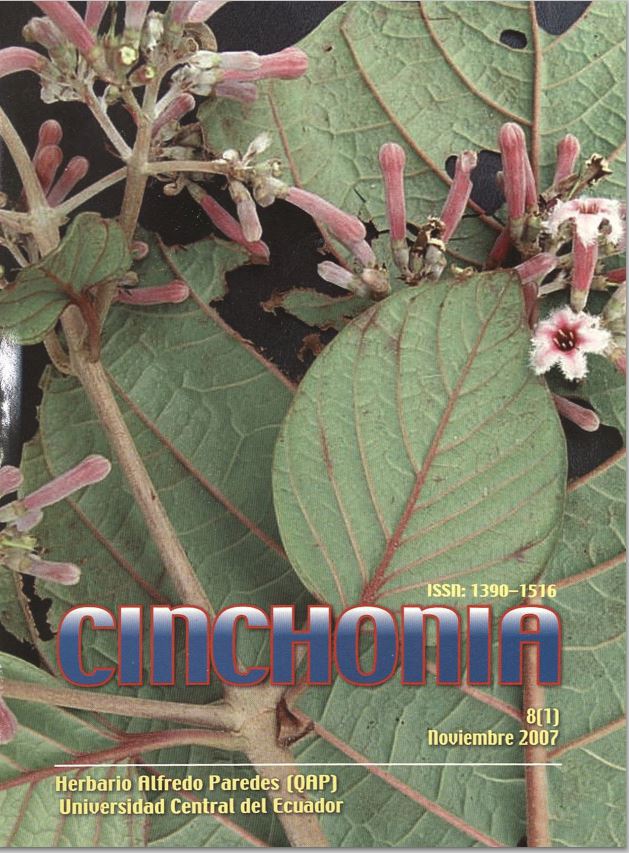PARCHES DE BOSQUE Y ETNOBOTÁNICA SHUAR EN PALORA, MORONA SANTIAGO-ECUADOR
Main Article Content
Abstract
The fieldwork realized in April, 1998, in the colony Tarquí, 78°01’W - 01°41’SS, 970 m (sampling 1) and in June, 2005 in the colony Atahualpa - community Shuar Santa Rosa, 78°05.06’W - 01°44’S, 1.200 m (sampling 2); 78°04.03’W - 01°44.52’S, 1.100 m (sampling 3), vegetable training forest siempreverde piemontano, cantón Palora, Morona Santiago’s province. One used transects of thousand meters in two localities and in the third 600, the species were analyzed 2.5 cm. of DAP. In Cinchonia Vol. 8, # 1, 2007 67 every locality two informants were polled in s¡- tu on the usefulness of the plants in the transects and in the surroundings. The samples settled in the herbarium QAP according to the number of Cerón et al. catalogue, series 35574 - 35688 and 54642 - 54779. For the analysis of the information, there was in use the Índex of Simpson’s diversity (ID) and that of Sorensen’s similarity (IS). In the sampling 1, was 295 individuáis, 94 species, ID = 58.5, interpreted as diversity on the average, the 5 most frequent species are: Iriartea deltoidea, Hedyosmum sprucei, Tabernaemontana sananho, Elaeagia utilis, Acalypha cuneata. In the sampling 2, 218 individuáis, 73 species, ID = 14.6, interpreted as low diversity, 5 more frequent species are: Wettinia maynensis, Pitcaimia bakerí, Clidemia caudata, I. deltoidea, Inga multinervis. In the sampling 3, 73 individuáis, 47 species, ID = 31.2, interpreted as low diversity, 5 more frequent species are: W. maynensis, Palicourea aff. nigricans, Faramea glandulosa, Inga ruiziana and Cecropia sciadophylla. Three samplings add 176 species and 7 (3.9%), of these they share three localities: F. glandulosa, Guatteria glaberrima, H. sprucei, Henriettella verrucosa, I. deltoidea, Pourouma minor and W. mayensis. The similarity between the samplings is: 1 vs. 2 = 16.8%, 1 vs. 3 = 22.7% and 2 vs. 3 = 21.7%. In the Ethnobotanic one registers the ñames and usefulness of 198 plants and two macrocospic mushrooms. In the sampling 1, 60% of the species have ñames and uses, in 2, 83.6%, and in 3, 53.2%. The most important family is Arecaceae, sonríe species as: Bactris setulosa (Camancha), I. deltoidea (Ampakay), Oenocarpus bataua (Kunkun), Prestoea schultzeana (Tenge mi) and W. maynensis (Tunduam), have up to 7 usefulness. The intensive exploitation of wood and transformation of the forest in pastizales, to turned into small patches and many of them disturbed or secondary, this long-term might be a threat for the National Park Sangay.

